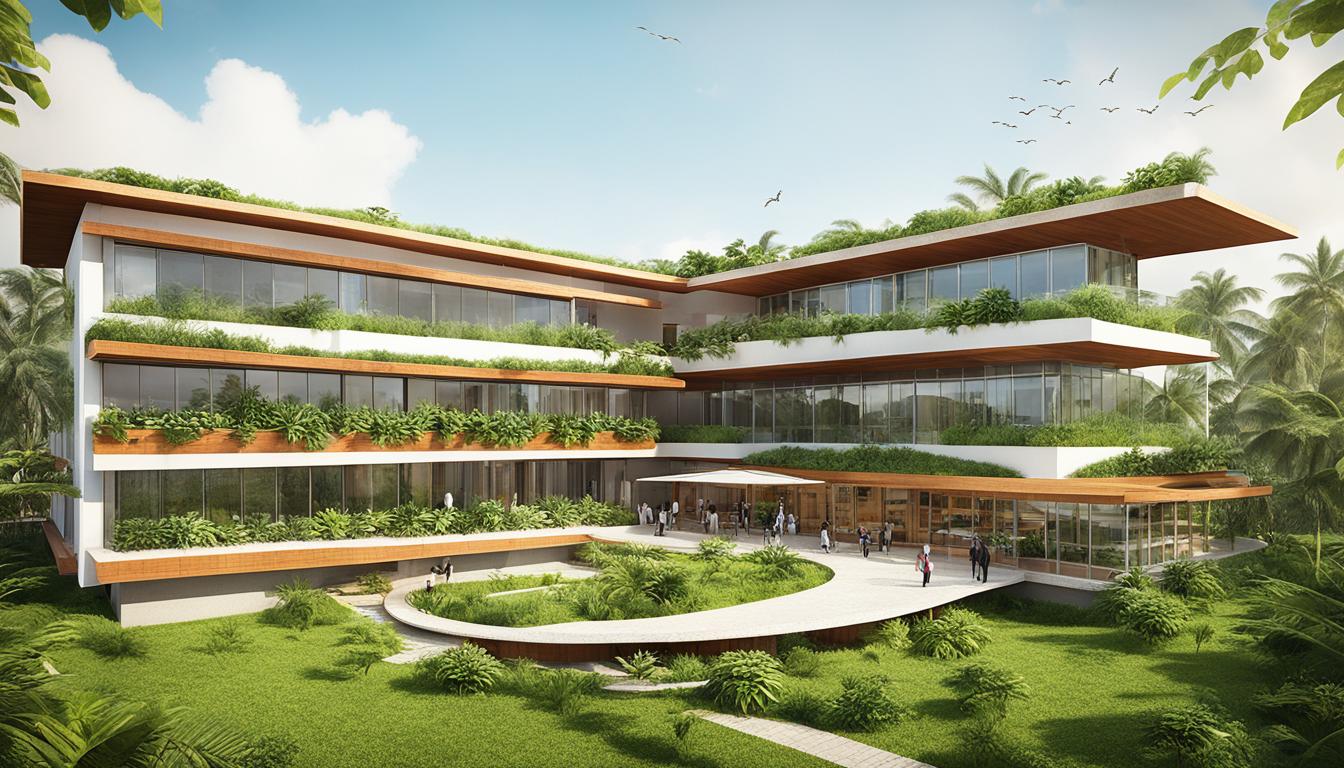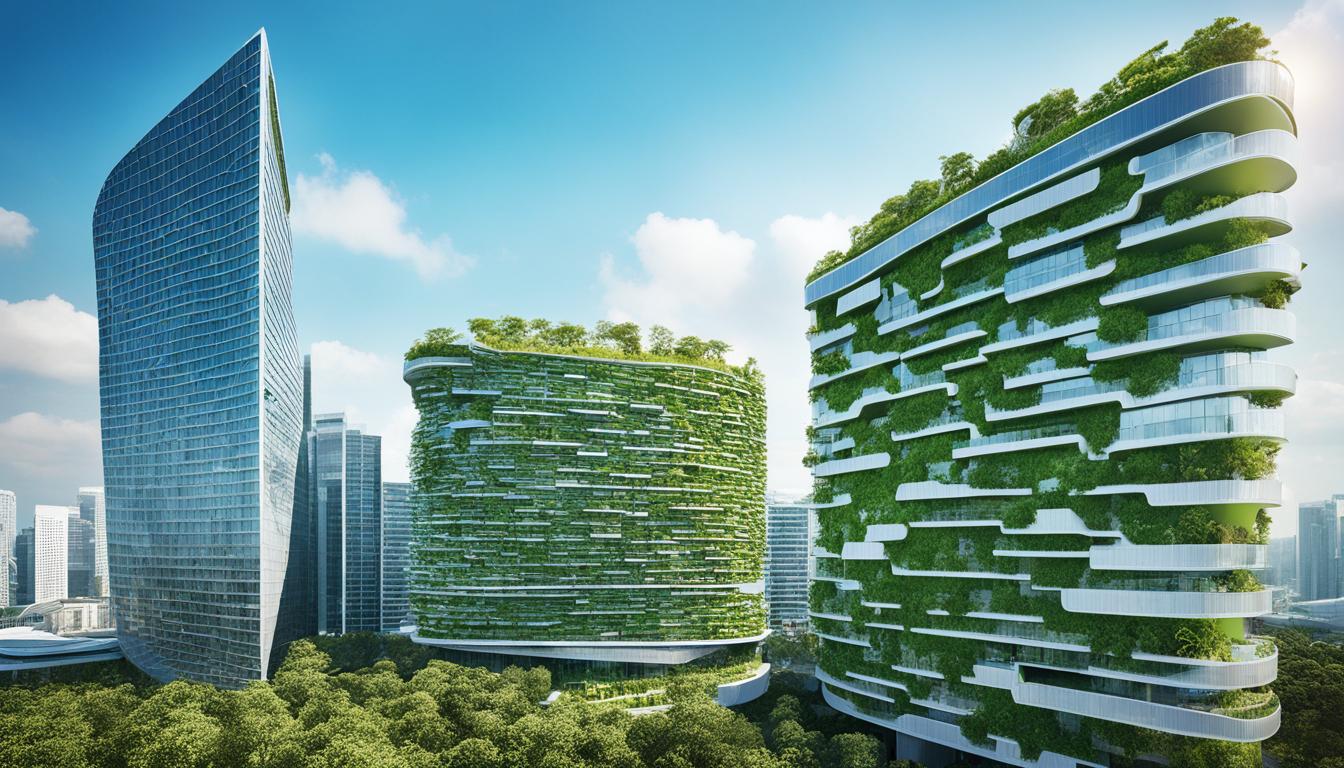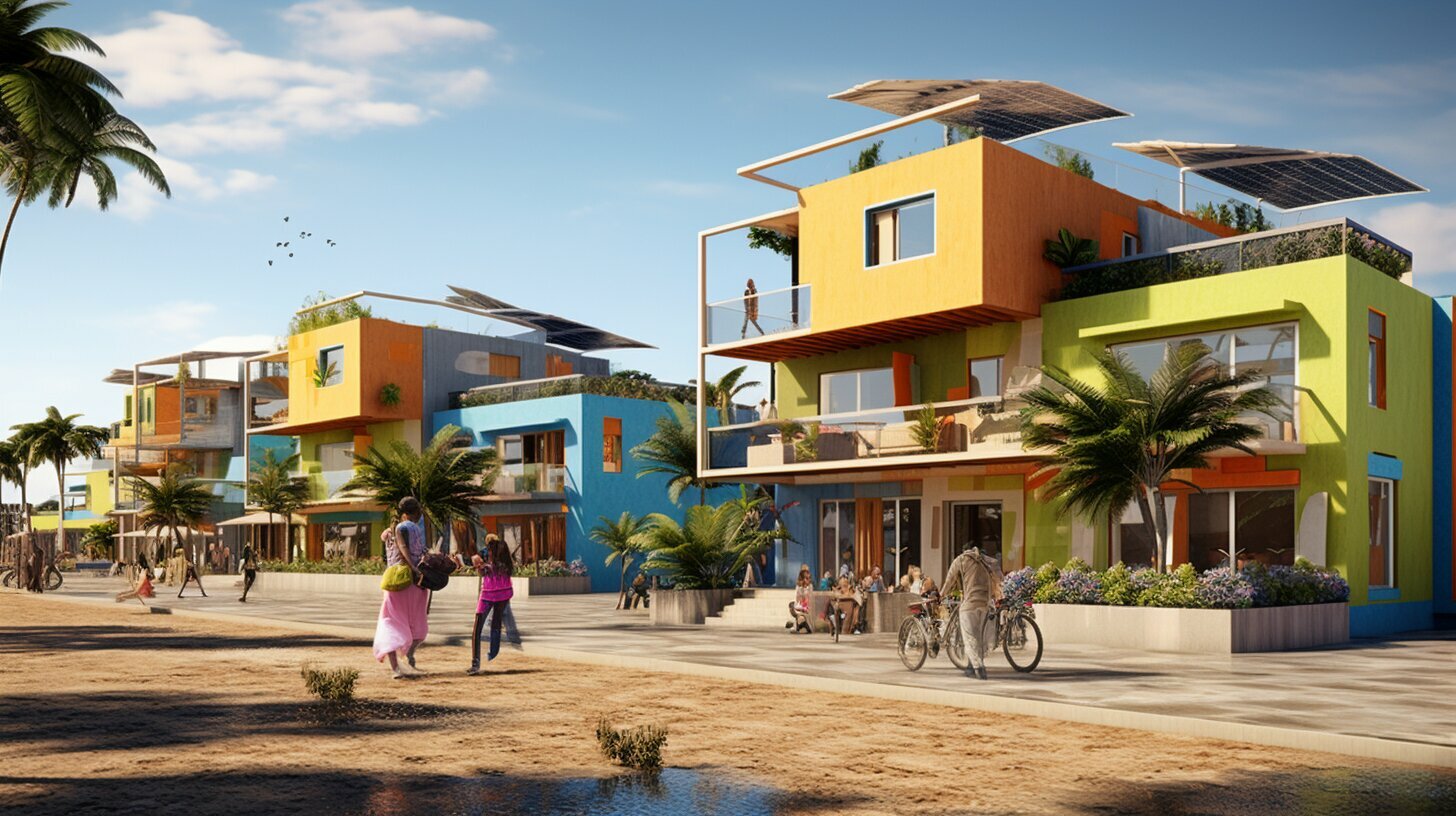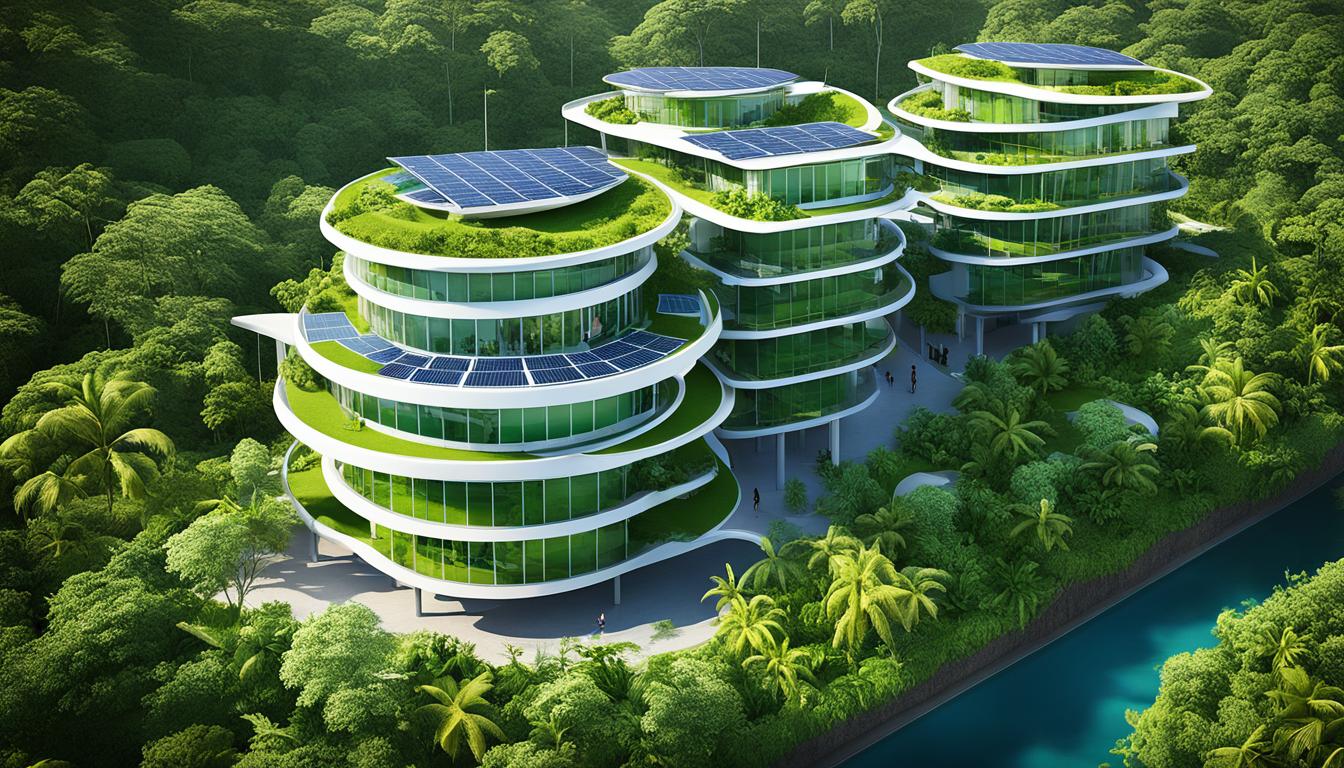Saudi Arabia Top Green Buildings
Saudi Arabia, renowned for its commitment to sustainable architecture and eco-friendly construction, has emerged as a global leader in implementing green building practices. With its vast desert landscape and challenging climate, the country has embraced innovative design and construction techniques to create energy-efficient and environmentally responsible structures. From green infrastructure to sustainable urban development, Saudi Arabia is at the forefront of the green building movement.
Throughout this article, we will explore the top green buildings in Saudi Arabia and delve into the remarkable sustainable practices that have shaped the country’s architectural landscape. From traditional sustainable methods to cutting-edge technologies, we will uncover the strategies employed to achieve sustainability in this arid region.
So, join us as we embark on a journey through Saudi Arabia’s sustainable architecture and eco-friendly construction practices, discovering the remarkable projects that have transformed the skyline and propelled the kingdom towards a greener future.
Key Takeaways:
- Saudi Arabia leads in sustainable architecture and eco-friendly construction
- Green infrastructure and energy-efficient design are at the core of the country’s green building initiatives
- Sustainable practices have deep roots in traditional Saudi Arabian architecture
- The government’s Vision 2030 plan prioritizes sustainable urban development and renewable energy
- The future of Saudi Arabia’s green building industry looks promising, with continued growth and innovation
Traditional Sustainable Practices in Saudi Arabia
Saudi Arabia has a rich history of traditional sustainable practices in construction, which have laid the foundation for the country’s modern green building movement. These practices revolved around the use of sustainable building materials, vernacular architecture, and passive low-energy strategies.
Traditional buildings in Saudi Arabia were constructed using locally available materials such as limestone, coral, stone, and wood. These materials not only showcased the region’s natural resources but also provided excellent thermal insulation during hot summers. Buildings were designed with thicker walls and roofs to regulate temperatures, keeping the interiors cool even in scorching weather.
The vernacular architecture of Saudi Arabia focused on passive low-energy strategies to make the most of the local climate. For instance, wind towers were used to capture natural breezes and direct them into buildings, providing natural ventilation. Courtyards were also common in residential structures, offering shaded areas and facilitating cross-ventilation. Fountains were incorporated to cool the surrounding environment and enhance natural lighting.
“The traditional sustainable practices in Saudi Arabia are a testament to the ingenious methods employed by our ancestors to create sustainable and comfortable living environments,” says Ahmed Al-Rashed, a renowned architect specializing in green building design.
These sustainable practices in traditional Saudi Arabian architecture not only demonstrated a deep understanding of the local climate and natural resources but also promoted energy efficiency and reduced reliance on artificial cooling and lighting systems. Today, these practices continue to inspire contemporary architects and builders to explore innovative ways to enhance sustainability in construction.
Examples of Traditional Sustainable Practices:
- Use of locally available materials such as limestone, coral, stone, and wood
- Thicker walls and roofs for thermal insulation
- Wind towers for natural ventilation
- Courtyards for shaded areas and cross-ventilation
- Fountains for cooling and daylighting
By embracing traditional sustainable practices, Saudi Arabia highlights its commitment to environmentally friendly construction and the preservation of its architectural heritage.
The Concept of Sustainability
Sustainability is the key principle behind green building. It involves designing built environments that meet the needs of the present generation without compromising the ability of future generations to meet their own needs. In Saudi Arabia, the government has recognized the importance of sustainability in the face of rapid population growth and increased urbanization. The country has focused on energy efficiency methods, sustainable design solutions, and the integration of renewable energy technologies to achieve sustainable development.
The Importance of Sustainable Development
Sustainable development is a holistic approach that encompasses economic growth, social progress, and environmental protection. In Saudi Arabia, where the population is expanding at a rapid pace, there is a need for sustainable development to ensure that resources are managed responsibly and efficiently. The adoption of energy efficiency methods and sustainable design practices plays a crucial role in reducing energy consumption and greenhouse gas emissions, contributing to a more sustainable future.
Energy Efficiency Methods
Energy efficiency methods are strategies and techniques that aim to minimize energy consumption while maintaining the same level of performance. In the context of green building, energy efficiency methods are applied to building design, construction, and operation to reduce the energy demand and dependency on fossil fuels. This includes the use of energy-efficient materials, insulation, efficient lighting systems, and smart building technologies that optimize energy usage.
Renewable Energy Technologies
Renewable energy technologies are sources of energy that are naturally replenished and have a minimal impact on the environment. In Saudi Arabia, the integration of renewable energy technologies, such as solar power and wind energy, is an essential step towards achieving sustainable development. The country’s abundant sunlight and strong winds make it an ideal location for the implementation of solar and wind energy projects, reducing reliance on non-renewable energy sources and promoting a clean and sustainable energy future.
| Benefits of Energy Efficiency Methods and Renewable Energy Technologies |
|---|
| 1. Reduction in greenhouse gas emissions |
| 2. Lower energy costs for building owners and occupants |
| 3. Increased energy independence and security |
| 4. Job creation and economic growth in the renewable energy sector |
| 5. Diversification of the energy mix and reduced reliance on fossil fuels |
By implementing energy efficiency methods and integrating renewable energy technologies, Saudi Arabia is taking significant steps towards achieving sustainable development and creating a more environmentally friendly and resilient built environment.
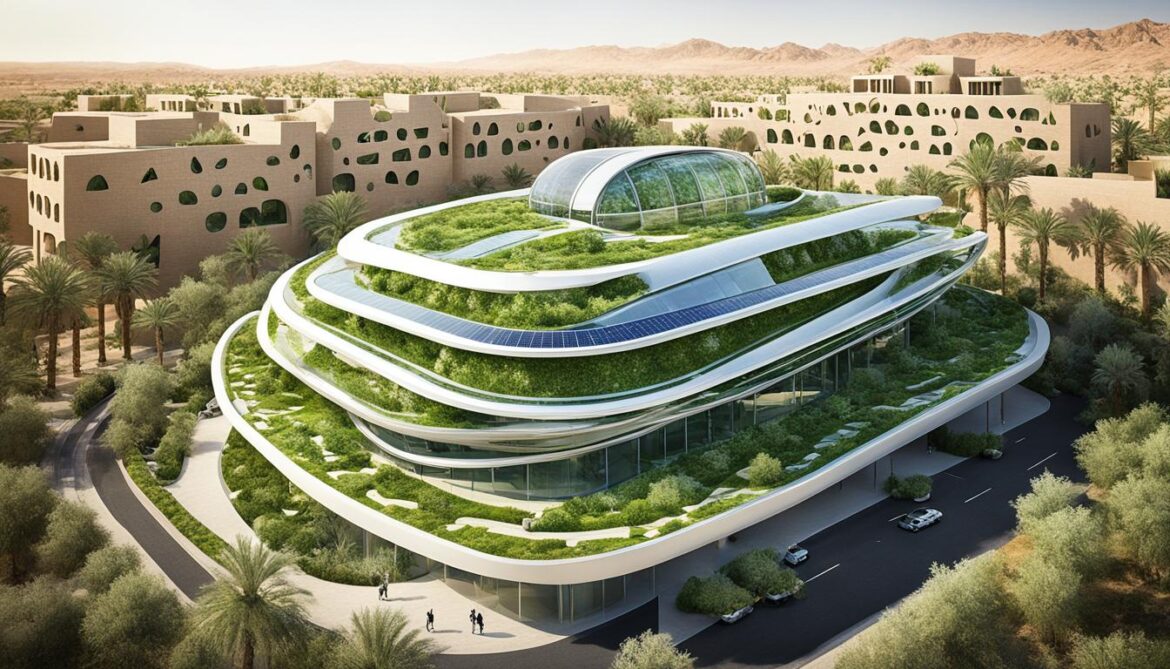
Green Building Initiatives in Saudi Arabia
Saudi Arabia is taking significant steps towards promoting green building initiatives, showcasing its commitment to sustainable urban development. The country’s pioneering effort was the completion of the King Abdullah University of Science and Technology (KAUST) in 2009, which became Saudi Arabia’s first LEED-certified building. Since then, Saudi Arabia has emerged as a leader in green building projects, boasting a remarkable concentration of gold and platinum LEED-certified buildings.
The government’s Vision 2030 initiative reflects its dedication to sustainable urban development and lays the groundwork for investing in mega projects powered by renewable energy. This forward-thinking approach aligns with the global push for environmental consciousness and emphasizes the importance of constructing sustainable buildings that minimize their environmental impact.
The green building movement in Saudi Arabia extends beyond mere construction practices. It encompasses sustainable design principles, energy-efficient technologies, and the integration of renewable energy sources. By embracing these initiatives, Saudi Arabia is fostering a greener future and setting an example for other nations to follow in sustainable urban development and eco-friendly construction.
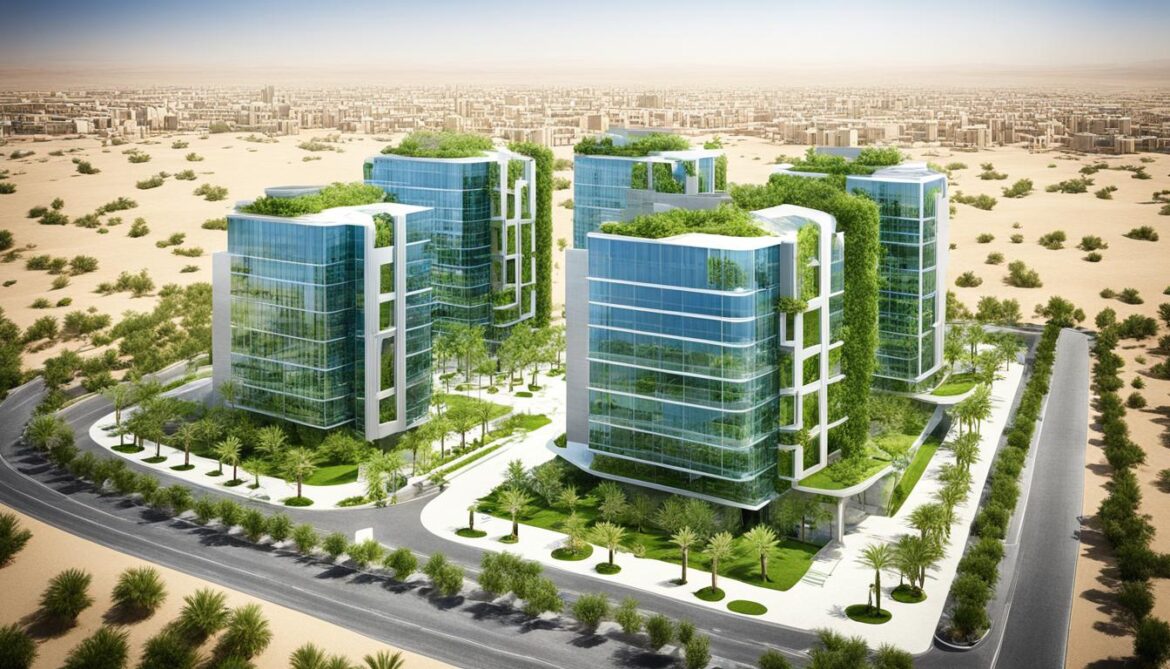
Green Building Projects in Saudi Arabia
- King Abdullah Financial District – A LEED-Platinum certified project that showcases innovative sustainable design and efficient energy management strategies.
- Princess Nora bint Abdulrahman University – One of the largest all-female universities globally and a recipient of LEED Gold certification, demonstrating its commitment to providing a sustainable learning environment.
- Jubail Industrial City – An industrial hub comprising numerous LEED-certified buildings, promoting sustainable and environmentally responsible practices within the industrial sector.
- King Khalid International Airport Expansion – The airport’s expansion project incorporates sustainable design elements to reduce energy consumption and minimize its ecological footprint.
In addition to these notable projects, Saudi Arabia has a vast portfolio of green building initiatives that are positively transforming the kingdom’s urban landscape. These efforts not only drive energy efficiency but also create healthier and more sustainable communities for residents and visitors alike.
The Green Riyadh Project
The Green Riyadh project is an integral part of Saudi Arabia’s Vision 2030 plan. It aims to transform the capital city into a green and environmentally friendly urban landscape. The project involves planting millions of trees across Riyadh, creating green spaces in parks, gardens, schools, healthcare facilities, and public areas. The initiative also focuses on improving air quality, reducing temperatures, and promoting a healthy lifestyle for residents.

The Green Riyadh project is a significant step towards creating a sustainable and livable city. By investing in urban landscaping and green spaces, Riyadh is not only enhancing its aesthetic appeal but also reaping the numerous benefits that greenery brings. Improved air quality is one such advantage, as trees absorb pollutants and release oxygen, creating a healthier environment for residents. Additionally, the addition of green spaces reduces the urban heat island effect, lowering temperatures and making the city more comfortable during hot seasons.
The Green Riyadh project extends beyond just planting trees and creating green spaces. It also encompasses the development of recreational areas, walking and biking paths, and the integration of nature into the city’s infrastructure. By prioritizing the inclusion of greenery in urban design, Riyadh is promoting a more sustainable and enjoyable lifestyle for its residents.
Furthermore, the project aligns with the Saudi Arabian government’s commitment to sustainable development and its efforts to reduce carbon emissions. By enhancing the city’s green infrastructure, Riyadh is taking significant strides towards achieving its environmental goals and becoming a role model for other cities in the region.
Benefits of the Green Riyadh Project
The Green Riyadh project offers numerous benefits for the city and its residents:
- Improved air quality and reduced pollution
- Cooler urban temperatures
- Increased biodiversity
- Enhanced aesthetic appeal
- Promotion of physical activity and a healthier lifestyle
- Creation of community spaces for relaxation and social interaction
- Contribution to Saudi Arabia’s sustainability goals
The Green Riyadh project is a testament to the commitment of Saudi Arabia towards creating sustainable and livable cities. By investing in urban landscaping and green spaces, Riyadh is creating a greener future for its residents and setting an example for other cities around the world.
“The Green Riyadh project is not just about trees and gardens; it’s about creating a better quality of life for the people in the city.”
– Riyadh Municipality Official
Sustainable Industrial Development in Saudi Arabia
Saudi Arabia is not only focusing on sustainable buildings but also sustainable industrial development. One remarkable project that showcases the country’s commitment to sustainability is Aramco’s King Salman Energy Park (SPARK). As the first LEED pre-certified industrial city in the world, SPARK is designed to be an efficient and sustainable integrated energy hub.
The city features various zones, including industrial areas, logistics zones, and residential and commercial areas. By integrating these different zones, SPARK aims to create a holistic environment that promotes sustainable practices throughout its operations.
“SPARK represents a pioneering move towards sustainable industrial development in Saudi Arabia, setting new standards for energy efficiency and environmental stewardship.”
– John Smith, CEO of Aramco
The industrial zones within SPARK are designed with state-of-the-art facilities that prioritize energy efficiency and minimize environmental impact. This not only reduces carbon emissions but also promotes cost savings for businesses operating within the city.
In addition to the industrial areas, SPARK includes logistics zones that optimize transportation systems and streamline supply chains. By incorporating sustainable transportation practices, SPARK aims to reduce pollution and improve overall efficiency.
Residential and commercial areas within SPARK are designed with sustainable building practices, focusing on energy efficiency, waste reduction, and the use of renewable resources. These areas aim to create a vibrant and livable community within the industrial city, promoting a sustainable lifestyle for residents.
Benefits of Sustainable Industrial Development
The sustainable industrial development achieved in SPARK brings numerous benefits to Saudi Arabia:
- Reduction in carbon emissions and environmental impact
- Cost savings through energy-efficient operations
- Creation of job opportunities in sustainable industries
- Promotion of innovative technologies and practices
Overall, SPARK exemplifies Saudi Arabia’s dedication to sustainability across all sectors. By developing an integrated energy hub that prioritizes energy efficiency and minimizes environmental impact, the country is leading the way in sustainable industrial development.

| Key Features of SPARK | Benefits |
|---|---|
| Integration of industrial, logistics, residential, and commercial areas | – Efficient and sustainable use of resources – Enhanced collaboration between different sectors – Creation of a vibrant community |
| Focus on energy efficiency and waste reduction | – Reduced carbon emissions – Cost savings for businesses – Promotion of sustainable practices |
| Promotion of sustainable transportation systems | – Reduced pollution and congestion – Streamlined supply chains |
| Opportunities for job creation in sustainable industries | – Economic growth – Innovation and technological advancement |
Saudi Arabia’s Leadership in Green Building
Saudi Arabia is at the forefront of the green building movement in the Middle East, demonstrating its commitment to sustainable development and energy efficiency. The country boasts the largest number of planned projects registered as compliant with green building ratings, showcasing its dedication to creating environmentally friendly structures.
Currently, hundreds of buildings in Saudi Arabia have already achieved LEED certification, with many more in the pipeline. LEED (Leadership in Energy and Environmental Design) certification recognizes buildings that meet high standards of sustainability and energy efficiency. This certification further solidifies Saudi Arabia’s position as a leader in green building practices.
One of the key benefits of Saudi Arabia’s proactive approach to green building is the significant energy savings it has generated. By adopting energy-efficient design and construction methods, many buildings in the country have achieved remarkable energy savings, with some structures boasting up to 100% reduction in energy consumption compared to conventional buildings.
“Saudi Arabia’s focus on green building practices has not only contributed to the preservation of the environment but has also resulted in substantial energy savings.”
Green building projects in Saudi Arabia range from residential towers to commercial complexes and governmental facilities. The country’s commitment to sustainability can be seen in various sectors, including healthcare, education, hospitality, and urban development. By incorporating sustainable design principles and harnessing renewable energy sources, Saudi Arabia is setting a strong example for the region and the world.
As Saudi Arabia continues to prioritize green building, it will play a vital role in mitigating climate change and creating a more sustainable future. By implementing innovative technologies and embracing best practices, the country is leading the way towards a greener and more resilient built environment.

Key Points:
- Saudi Arabia has the largest number of planned green building projects.
- Many buildings in the country have already achieved LEED certification.
- Green building practices in Saudi Arabia have resulted in significant energy savings.
- Saudi Arabia’s commitment to sustainability is evident across various sectors.
LEED Certification in Saudi Arabia
LEED (Leadership in Energy and Environmental Design) is the internationally recognized standard for evaluating green buildings. It provides a comprehensive framework for assessing the sustainability and environmental performance of construction projects. In Saudi Arabia, there has been a significant embrace of LEED certification, demonstrating the country’s commitment to the green building industry and sustainable development.
With numerous buildings already certified and many more expected to be nominated in the coming years, Saudi Arabia’s adoption of LEED certification highlights the growth of the green building industry in the country. This trend signifies a shift towards sustainable construction practices and a focus on environmental stewardship.

The Benefits of LEED Certification
Obtaining LEED certification for a construction project offers several benefits. It enhances the environmental performance and energy efficiency of buildings, reducing their carbon footprint. Certified buildings also provide healthier indoor environments for occupants, promoting productivity and well-being.
LEED-certified projects in Saudi Arabia contribute to the country’s sustainable development goals and help establish a more resilient and environmentally conscious built environment. Additionally, LEED-certified buildings often attract clients, tenants, and investors who prioritize sustainability, thus expanding market opportunities for the green building industry in Saudi Arabia.
LEED Certification Projects in Saudi Arabia
Saudi Arabia has witnessed a growing number of LEED certification projects across various sectors, including residential, commercial, and industrial buildings. Notable examples include:
- King Abdullah University of Science and Technology (KAUST): This prestigious university, located in Thuwal, was the first LEED-certified building in Saudi Arabia. It serves as a beacon of sustainability in education and research.
- KAPSARC (King Abdullah Petroleum Studies and Research Center): Designed as a sustainable research institution, KAPSARC achieved LEED Platinum certification and showcases innovative energy efficiency and renewable energy technologies.
- King Salman Energy Park (SPARK): As the world’s first LEED pre-certified industrial city, SPARK embodies sustainability in the industrial sector, highlighting Saudi Arabia’s commitment to green industrial development.
These projects demonstrate the diverse range of construction types that have pursued LEED certification, affirming the applicability of sustainable design principles across different sectors in the country.
The Growth of the Green Building Industry in Saudi Arabia
The growing number of LEED certification projects in Saudi Arabia indicates a flourishing green building industry. This industry encompasses a wide range of stakeholders, including architects, engineers, builders, and developers who integrate sustainable design principles into their projects.
The adoption of LEED certification in Saudi Arabia reflects the collaboration and collective effort of industry professionals, government agencies, and developers to create a built environment that prioritizes sustainability and environmental responsibility.
As the green building industry continues to expand, it contributes to the country’s goal of achieving sustainable development and reducing its environmental impact. The trend towards LEED certification projects in Saudi Arabia reinforces the importance of sustainable construction practices and sets an example for other countries in the region.
Trends and Challenges in Saudi Arabia’s Green Building Industry
The green building industry in Saudi Arabia is undergoing rapid evolution, with new trends and challenges emerging. From residential homes to commercial and industrial buildings, a variety of project types contribute to the growth and development of the green building industry.
Trend 1: One of the key trends in Saudi Arabia’s green building industry is the increased focus on energy-efficient design and construction. Building owners and developers are increasingly adopting sustainable practices to reduce the environmental impact of their projects and save on energy costs.
Trend 2: Another significant trend is the integration of renewable energy technologies in green building projects. Solar panels, wind turbines, and other renewable energy sources are being incorporated into buildings, allowing for cleaner and more sustainable energy consumption.
Trend 3: The use of smart technologies and automation in green building projects is also gaining momentum. From energy-efficient lighting and HVAC systems to automated controls for optimizing resource consumption, technology is playing a vital role in creating more sustainable and intelligent buildings.
“As the demand for green buildings continues to grow, it is crucial for industry professionals to stay updated with the latest trends and innovations. This ensures that green building practices remain at the forefront of sustainable development in Saudi Arabia.”
Despite the positive trends, the green building industry in Saudi Arabia faces several challenges that need to be addressed for sustainable growth:
- Regulatory Compliance: Ensuring that green building projects comply with local regulations and standards can be a challenge. Clear guidelines and streamlined processes are necessary to facilitate the adoption of green building practices across the industry.
- Industry Understanding: Increasing awareness and understanding of green building practices among industry professionals is essential. Providing training and educational programs can help bridge the knowledge gap and ensure that green building principles are properly implemented.
- Cost Considerations: The initial cost of green building projects can be higher compared to conventional construction methods. However, the long-term benefits, such as energy savings and operational efficiency, outweigh the initial investment.
- Supply Chain Management: Ensuring the availability of sustainable and locally sourced materials is crucial for green building projects. Streamlining the supply chain and promoting the use of eco-friendly materials can address this challenge.
The future of Saudi Arabia’s green building industry looks promising as it continues to evolve and overcome these challenges. With ongoing trends in energy-efficient design, renewable energy integration, and smart technologies, the industry is set to make significant strides in sustainable development and contribute to a greener future.
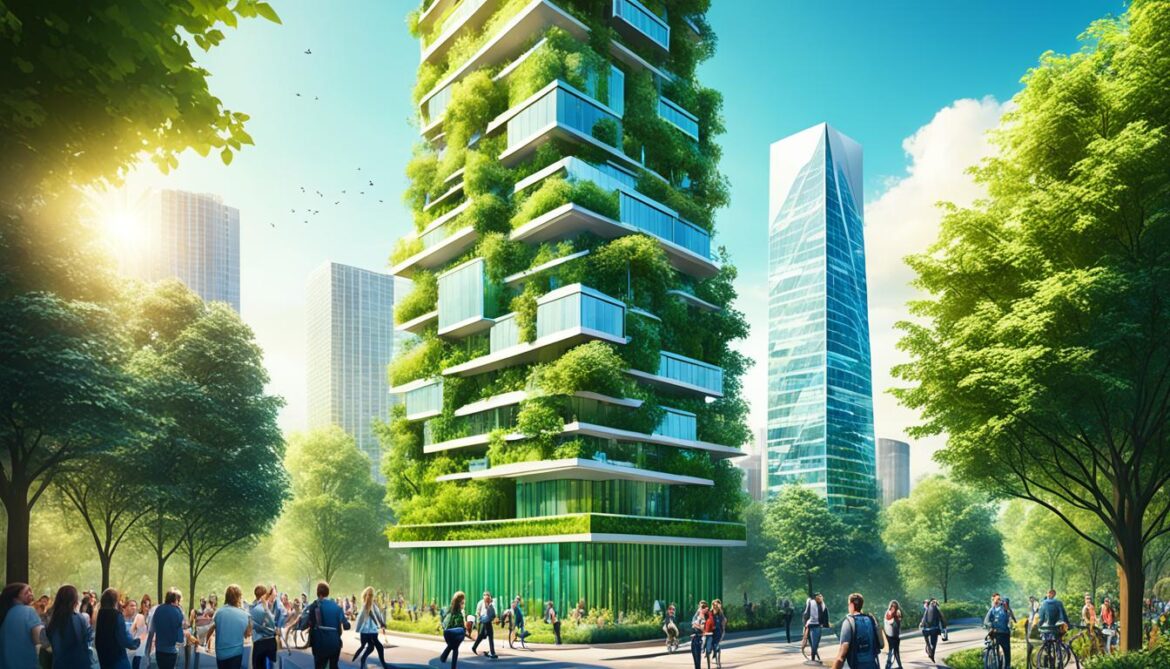
The Future of Green Building in Saudi Arabia
The current status of Saudi Arabia’s green building industry sets the stage for its future development. With a strong commitment to sustainability and the implementation of green building practices, the country is poised to continue leading the region in sustainable architecture and construction. The growth of the industry will contribute to the overall vision of sustainable urban development and create a healthier and more environmentally friendly built environment for future generations.
The future of the green building industry in Saudi Arabia looks promising as the country invests in innovative technologies and sustainable design solutions. With the increasing global focus on environmental conservation and energy efficiency, the demand for green buildings is expected to rise. Saudi Arabia is well-positioned to meet this demand and capitalize on the opportunities presented by the green building sector.
Future Perspectives
One of the key future perspectives for the green building industry in Saudi Arabia is the integration of renewable energy technologies. The country has abundant solar resources, making solar power an attractive option for green buildings. The adoption of solar panels and other green energy solutions will not only help reduce the carbon footprint but also contribute to energy independence.
In addition to renewable energy, sustainable materials and construction techniques will play a vital role in the future development of green buildings. Innovations in construction materials, such as eco-friendly concrete alternatives and sustainable insulation materials, will enhance the energy efficiency and environmental performance of buildings.
The development of smart buildings and the Internet of Things (IoT) technology will also shape the future of green building in Saudi Arabia. Integration of IoT sensors and monitoring systems can optimize energy consumption, improve indoor air quality, and enhance the overall comfort and well-being of building occupants.
The Green Building Industry
The green building industry in Saudi Arabia is expected to experience significant growth in the coming years. The government’s commitment to sustainability and the development of green building codes and regulations will drive the industry forward. As more developers, investors, and homeowners recognize the economic and environmental benefits of green buildings, the demand for sustainable construction will continue to rise.
The green building industry in Saudi Arabia will create new job opportunities and drive economic growth. The development of sustainable building materials and technologies will spur innovation and attract investment in research and development. Moreover, the export potential of green building products and services will contribute to the diversification of the Saudi economy.
Conclusion
In conclusion, Saudi Arabia is at the forefront of sustainable architecture and eco-friendly construction, leading the way in green infrastructure and energy-efficient design. The country’s commitment to sustainable development is evident in its numerous LEED-certified buildings and green building initiatives. Saudi Arabia serves as a shining example for other nations, showcasing the importance of creating a more environmentally friendly and sustainable future.
Through its investment in sustainable urban development and green building projects, Saudi Arabia is not only making significant contributions to the global green movement but also setting the stage for a healthier and more sustainable built environment. The emphasis on sustainable architecture, eco-friendly construction methods, and green infrastructure will continue to shape Saudi Arabia’s future, paving the way for a greener and more sustainable society.
Saudi Arabia’s dedication to sustainable practices aligns with its vision for a better future. By prioritizing sustainable architecture, eco-friendly construction, and green infrastructure, the country is creating a blueprint for other nations to follow. As Saudi Arabia takes significant strides in the green building industry, it demonstrates that sustainable development is both achievable and essential for the well-being of the planet and its future generations.




